Electrochemical DNA Biosensor for Detection of Hepatitis C Virus Using a 3D Poly-L-Lysine/Carbon Nanotube Film
Abstract
1. Introduction
2. Materials and Methods
2.1. Reagents
- Probe single stranded DNA: (AminoC6) 5′gggtaccgcccttgcgagtc 3′ (probe ssDNA);
- Complementary ssDNA: 5′ gactcgcaagggcggtaccc 3′ (cDNA);
- Non-complementary ssDNA: 5′gggtaccgcccttgcgagtc3′ (ncDNA).
2.2. Apparatus
2.3. Preparation of the DNA Biosensor
2.4. Immobilization of the Probe ssDNA and Analytical Responses
3. Results and Discussion
3.1. Characterization of CNT/PLL/GCE
3.2. Characterizations of the CNT/PLL Sensor Platform
3.3. Experimental Optimizations
3.4. Analytical Responses
4. Conclusions
Supplementary Materials
Author Contributions
Funding
Institutional Review Board Statement
Informed Consent Statement
Data Availability Statement
Conflicts of Interest
References
- Antoniou, T.; Pritlove, C.; Shearer, D.; Tadrous, M.; Shah, H.; Gomes, T. Accessing Hepatitis C Direct Acting Antivirals among People Living with Hepatitis C: A Qualitative Study. Int. J. Equity Health 2023, 22, 112. [Google Scholar] [CrossRef]
- Torre, P.; Festa, M.; Sarcina, T.; Masarone, M.; Persico, M. Elimination of HCV Infection: Recent Epidemiological Findings, Barriers, and Strategies for the Coming Years. Viruses 2024, 16, 1792. [Google Scholar] [CrossRef]
- Li, J.; Pang, L.; Liu, Z. Interpretation of the National Action Plan for Eliminating Hepatitis C as a Public Health Threat (2021–2030). China CDC Wkly. 2022, 4, 627–630. [Google Scholar] [PubMed]
- Adane, T.; Getawa, S. The Prevalence and Associated Factors of Hepatitis B and C Virus in Hemodialysis Patients in Africa: A Systematic Review and Meta-Analysis. PLoS ONE 2021, 16, e0251570. [Google Scholar] [CrossRef] [PubMed]
- Kanokudom, S.; Poovorawan, K.; Nilyanimit, P.; Suntronwong, N.; Aeemjinda, R.; Honsawek, S.; Poovorawan, Y. Comparison of Anti-HCV Combined with HCVcAg (Elecsys HCV Duo Immunoassay) and Anti-HCV Rapid Test Followed by HCV RNA Analysis Using QRT-PCR to Identify Active Infection for Treatment. PLoS ONE 2024, 19, e0313771. [Google Scholar] [CrossRef] [PubMed]
- El-Said, W.A.; Choi, J. High Selective Spectroelectrochemical Biosensor for HCV-RNA Detection Based on a Specific Peptide Nucleic Acid. Spectrochim. Acta A Mol. Biomol. Spectrosc. 2019, 217, 288–293. [Google Scholar] [CrossRef]
- Kornienko, I.V.; Aramova, O.Y.; Tishchenko, A.A.; Rudoy, D.V.; Chikindas, M.L. RNA Stability: A Review of the Role of Structural Features and Environmental Conditions. Molecules 2024, 29, 5978. [Google Scholar] [CrossRef]
- Roux, C.; Ramos-Hue, M.; Audonnet, M.; Duviau, M.-P.; Nouaille, S.; Carpousis, A.J.; Laguerre, S.; Hajnsdorf, E.; Cocaign-Bousquet, M.; Girbal, L. RNA Stability Is Regulated by Both RNA Polyadenylation and ATP Levels, Linking RNA and Energy Metabolisms in Escherichia coli. mBio 2025, 16, e02680-24. [Google Scholar] [CrossRef]
- Tani, H. Recent Advances and Prospects in RNA Drug Development. Int. J. Mol. Sci. 2024, 25, 12284. [Google Scholar] [CrossRef]
- Hua, Y.; Ma, J.; Li, D.; Wang, R. DNA-Based Biosensors for the Biochemical Analysis: A Review. Biosensors 2022, 12, 183. [Google Scholar] [CrossRef]
- Kim, J.H.; Suh, Y.J.; Park, D.; Yim, H.; Kim, H.; Kim, H.J.; Yoon, D.S.; Hwang, K.S. Technological Advances in Electrochemical Biosensors for the Detection of Disease Biomarkers. Biomed. Eng. Lett. 2021, 11, 309–334. [Google Scholar] [CrossRef]
- Antipchik, M.; Korzhikova-Vlakh, E.; Polyakov, D.; Tarasenko, I.; Reut, J.; Öpik, A.; Syritski, V. An Electrochemical Biosensor for Direct Detection of Hepatitis C Virus. Anal. Biochem. 2021, 624, 114196. [Google Scholar] [CrossRef]
- Mahardika, I.H.; Naorungroj, S.; Khamcharoen, W.; Kin, S.; Rodthongkum, N.; Chailapakul, O.; Shin, K. Point-of-Care Testing (POCT) Devices for DNA Detection: A Comprehensive Review. Adv. NanoBioMed Res. 2023, 3, 2300058. [Google Scholar] [CrossRef]
- González-Fernández, E.; Staderini, M.; Avlonitis, N.; Murray, A.F.; Mount, A.R.; Bradley, M. Effect of Spacer Length on the Performance of Peptide-Based Electrochemical Biosensors for Protease Detection. Sens. Actuators B Chem. 2018, 255, 3040–3046. [Google Scholar] [CrossRef]
- Milić, J.V. Multifunctional Layered Hybrid Perovskites. J. Mater. Chem. C Mater. 2021, 9, 11428–11443. [Google Scholar] [CrossRef]
- Mohd Nurazzi, N.; Asyraf, M.R.M.; Khalina, A.; Abdullah, N.; Sabaruddin, F.A.; Kamarudin, S.H.; Ahmad, S.; Mahat, A.M.; Lee, C.L.; Aisyah, H.A.; et al. Fabrication, Functionalization, and Application of Carbon Nanotube-Reinforced Polymer Composite: An Overview. Polymers 2021, 13, 1047. [Google Scholar] [CrossRef] [PubMed]
- Sezer, N.; Koç, M. Oxidative Acid Treatment of Carbon Nanotubes. Surf. Interfaces 2019, 14, 1–8. [Google Scholar] [CrossRef]
- Garrett, D.J.; Flavel, B.S.; Shapter, J.G.; Baronian, K.H.R.; Downard, A.J. Robust Forests of Vertically Aligned Carbon Nanotubes Chemically Assembled on Carbon Substrates. Langmuir 2010, 26, 1848–1854. [Google Scholar] [CrossRef]
- Daza Millone, M.A.; Ramirez, E.A.; Chain, C.Y.; Crivaro, A.; Romanin, D.; Rumbo, M.; Docena, G.; Cocco, M.D.; Pedano, M.L.; Fainstein, A.; et al. SPR Biosensing MUA/Poly-L-Lysine Platform for the Detection of 2,4-Dinitrophenol as Small Molecule Model System. J. Nanomater. 2016, 2016, 5432656. [Google Scholar] [CrossRef]
- Sahiner, N. Single Step Poly(L-Lysine) Microgel Synthesis, Characterization and Biocompatibility Tests. Polymer 2017, 121, 46–54. [Google Scholar] [CrossRef]
- Silva, P.M.S.; Lima, A.L.R..; Silva, B.V.M.; Coelho, L.C.B.B.; Dutra, R.F.; Correia, M.T.S. Cratylia Mollis Lectin Nanoelectrode for Differential Diagnostic of Prostate Cancer and Benign Prostatic Hyperplasia Based on Label-Free Detection. Biosens. Bioelectron. 2016, 85, 171–177. [Google Scholar] [CrossRef] [PubMed]
- Sun, X.; Shao, H.; Xiang, K.; Yan, Y.; Yu, X.; Li, D.; Wu, W.; Zhou, L.; So, K.-F.; Ren, Y.; et al. Poly(Dopamine)-Modified Carbon Nanotube Multilayered Film and Its Effects on Macrophages. Carbon 2017, 113, 176–191. [Google Scholar] [CrossRef]
- Adeboyejo, K.; Grosche, V.R.; José, D.P.; Ferreira, G.M.; Shimizu, J.F.; King, B.J.; Tarr, A.W.; Soares, M.M.C.N.; Ball, J.K.; McClure, C.P.; et al. Simultaneous Determination of HCV Genotype and NS5B Resistance Associated Substitutions Using Dried Serum Spots from São Paulo State, Brazil. Access Microbiol. 2022, 4, 000326. [Google Scholar] [CrossRef] [PubMed]
- Malik, A.A.; Chotpatiwetchkul, W.; Phanus-umporn, C.; Nantasenamat, C.; Charoenkwan, P.; Shoombuatong, W. StackHCV: A Web-Based Integrative Machine-Learning Framework for Large-Scale Identification of Hepatitis C Virus NS5B Inhibitors. J. Comput. Aided Mol. Des. 2021, 35, 1037–1053. [Google Scholar] [CrossRef]
- Sabariegos, R.; Albentosa-González, L.; Palmero, B.; Clemente-Casares, P.; Ramírez, E.; García-Crespo, C.; Gallego, I.; de Ávila, A.I.; Perales, C.; Domingo, E.; et al. Akt Phosphorylation of Hepatitis C Virus NS5B Regulates Polymerase Activity and Hepatitis C Virus Infection. Front. Microbiol. 2021, 12, 754664. [Google Scholar] [CrossRef]
- da Fonseca Alves, R.; Franco, D.L.; Cordeiro, M.T.; de Oliveira, E.M.; Fireman Dutra, R.A.; Del Pilar Taboada Sotomayor, M. Novel Electrochemical Genosensor for Zika Virus Based on a Poly-(3-Amino-4-Hydroxybenzoic Acid)-Modified Pencil Carbon Graphite Electrode. Sens. Actuators B Chem. 2019, 296, 126681. [Google Scholar] [CrossRef]
- Ferrari, L.; Rovati, L.; Fabbri, P.; Pilati, F. Photobleaching Effects in Organic Thin Film Sensing Probes. In Proceedings of the 2012 IEEE International Instrumentation and Measurement Technology Conference Proceedings, Graz, Austria, 13–16 May 2012; pp. 1235–1239. [Google Scholar]
- Savas, S.; Sarıçam, M. A Novel PCR-Free Ultrasensitive GQD-Based Label-Free Electrochemical DNA Sensor for Sensitive and Rapid Detection of Francisella Tularensis. Micromachines 2024, 15, 1308. [Google Scholar] [CrossRef]
- Kim, S.K.; Oh, Y.H.; Ko, D.H.; Sung, H.; Oh, H.B.; Hwang, S.H. Nanoparticle-Based Visual Detection of Amplified DNA for Diagnosis of Hepatitis C Virus. Biosensors 2022, 12, 744. [Google Scholar] [CrossRef]
- Fang, C.S.; Kim, K.; Yu, B.; Jon, S.; Kim, M.-S.; Yang, H. Ultrasensitive Electrochemical Detection of MiRNA-21 Using a Zinc Finger Protein Specific to DNA–RNA Hybrids. Anal. Chem. 2017, 89, 2024–2031. [Google Scholar] [CrossRef]
- Liu, L.; Wang, X.; Ma, Q.; Lin, Z.; Chen, S.; Li, Y.; Lu, L.; Qu, H.; Su, X. Multiplex Electrochemiluminescence DNA Sensor for Determination of Hepatitis B Virus and Hepatitis C Virus Based on Multicolor Quantum Dots and Au Nanoparticles. Anal. Chim. Acta 2016, 916, 92–101. [Google Scholar] [CrossRef]
- Trotter, M.; Borst, N.; Thewes, R.; von Stetten, F. Review: Electrochemical DNA Sensing—Principles, Commercial Systems, and Applications. Biosens. Bioelectron. 2020, 154, 112069. [Google Scholar] [CrossRef]
- Ferapontova, E.E. DNA Electrochemistry and Electrochemical Sensors for Nucleic Acids. Annu. Rev. Anal. Chem. 2018, 11, 197–218. [Google Scholar] [CrossRef] [PubMed]
- Hai, X.; Li, Y.; Zhu, C.; Song, W.; Cao, J.; Bi, S. DNA-Based Label-Free Electrochemical Biosensors: From Principles to Applications. TrAC Trends Anal. Chem. 2020, 133, 116098. [Google Scholar] [CrossRef]
- Benkaddour, A.; Jradi, K.; Robert, S.; Daneault, C. Grafting of Polycaprolactone on Oxidized Nanocelluloses by Click Chemistry. Nanomaterials 2013, 3, 141–157. [Google Scholar] [CrossRef] [PubMed]
- Östergren, I.; Darmadi, I.; Lerch, S.; da Silva, R.R.; Craighero, M.; Paleti, S.H.K.; Moth-Poulsen, K.; Langhammer, C.; Müller, C. A Surface Passivated Fluorinated Polymer Nanocomposite for Carbon Monoxide Resistant Plasmonic Hydrogen Sensing. J. Mater. Chem. A Mater. 2024, 12, 7906–7915. [Google Scholar] [CrossRef]
- García-Barrera, L.J.; Meza-Zamora, S.A.; Noa-Carrazana, J.C.; Delgado-Macuil, R.J. Chemometric Analysis Using Infrared Spectroscopy and PCA-LDA for Early Diagnosis of Fusarium Oxysporum in Tomato. J. Plant Dis. Prot. 2024, 131, 1609–1626. [Google Scholar] [CrossRef]
- Morsin, M.; Nafisah, S.; Sanudin, R.; Razali, N.L.; Mahmud, F.; Soon, C.F. The Role of Positively Charge Poly-L-Lysine in the Formation of High Yield Gold Nanoplates on the Surface for Plasmonic Sensing Application. PLoS ONE 2021, 16, e0259730. [Google Scholar] [CrossRef]
- Mendonça, P.D.; Santos, L.K.B.; Foguel, M.V.; Rodrigues, M.A.B.; Cordeiro, M.T.; Gonçalves, L.M.; Marques, E.T.A.; Dutra, R.F. NS1 Glycoprotein Detection in Serum and Urine as an Electrochemical Screening Immunosensor for Dengue and Zika Virus. Anal. Bioanal. Chem. 2021, 413, 4873–4885. [Google Scholar] [CrossRef]
- Saadati, A.; Hassanpour, S.; Bahavarnia, F.; Hasanzadeh, M. A Novel Biosensor for the Monitoring of Ovarian Cancer Tumor Protein CA 125 in Untreated Human Plasma Samples Using a Novel Nano-Ink: A New Platform for Efficient Diagnosis of Cancer Using Paper Based Microfluidic Technology. Anal. Methods 2020, 12, 1639–1649. [Google Scholar] [CrossRef]
- Liang, G.; Man, Y.; Li, A.; Jin, X.; Liu, X.; Pan, L. DNAzyme-Based Biosensor for Detection of Lead Ion: A Review. Microchem. J. 2017, 131, 145–153. [Google Scholar] [CrossRef]
- Dias, A.C.M.S.; Gomes-Filho, S.L.R.; Silva, M.M.S.; Dutra, R.F. A Sensor Tip Based on Carbon Nanotube-Ink Printed Electrode for the Dengue Virus NS1 Protein. Biosens. Bioelectron. 2013, 44, 216–221. [Google Scholar] [CrossRef]
- El-Sheikh, S.M.; Osman, D.I.; Ali, O.I.; Shousha, W.G.; Shoeib, M.A.; Shawky, S.M.; Sheta, S.M. A Novel Ag/Zn Bimetallic MOF as a Superior Sensitive Biosensing Platform for HCV-RNA Electrochemical Detection. Appl. Surf. Sci. 2021, 562, 150202. [Google Scholar] [CrossRef]
- Chaibun, T.; Karunaithas, S.; Ngamdee, T.; Wasitthankasem, R.; Lapchai, S.; Poovorawan, Y.; Yin, L.S.; Lertanantawong, B. Highly Sensitive and Specific Electrochemical Biosensor for Direct Detection of Hepatitis C Virus RNA in Clinical Samples Using DNA Strand Displacement. Sci. Rep. 2024, 14, 23792. [Google Scholar] [CrossRef]
- Roohizadeh, A.; Ghaffarinejad, A.; Salahandish, R.; Omidinia, E. Label-Free RNA-Based Electrochemical Nanobiosensor for Detection of Hepatitis C. Curr. Res. Biotechnol. 2020, 2, 187–192. [Google Scholar] [CrossRef]
- Sheta, S.M.; El-Sheikh, S.M.; Osman, D.I.; Salem, A.M.; Ali, O.I.; Harraz, F.A.; Shousha, W.G.; Shoeib, M.A.; Shawky, S.M.; Dionysiou, D.D. A Novel HCV Electrochemical Biosensor Based on a Polyaniline@Ni-MOF Nanocomposite. Dalton Trans. 2020, 49, 8918–8926. [Google Scholar] [CrossRef] [PubMed]
- Oliveira, D.A.; Silva, J.V.; Flauzino, J.M.R.; Sousa, H.S.; Castro, A.C.H.; Moço, A.C.R.; Soares, M.M.C.N.; Madurro, J.M.; Brito-Madurro, A.G. Carbon Nanomaterial as Platform for Electrochemical Genosensor: A System for the Diagnosis of the Hepatitis C in Real Sample. J. Electroanal. Chem. 2019, 844, 6–13. [Google Scholar] [CrossRef]
- Chittuam, K.; Jampasa, S.; Vilaivan, T.; Tangkijvanich, P.; Chuaypen, N.; Avihingsanon, A.; Sain, M.; Panraksa, Y.; Chailapakul, O. Electrochemical Capillary-Driven Microfluidic DNA Sensor for HIV-1 and HCV Coinfection Analysis. Anal. Chim. Acta 2023, 1265, 341257. [Google Scholar] [CrossRef]
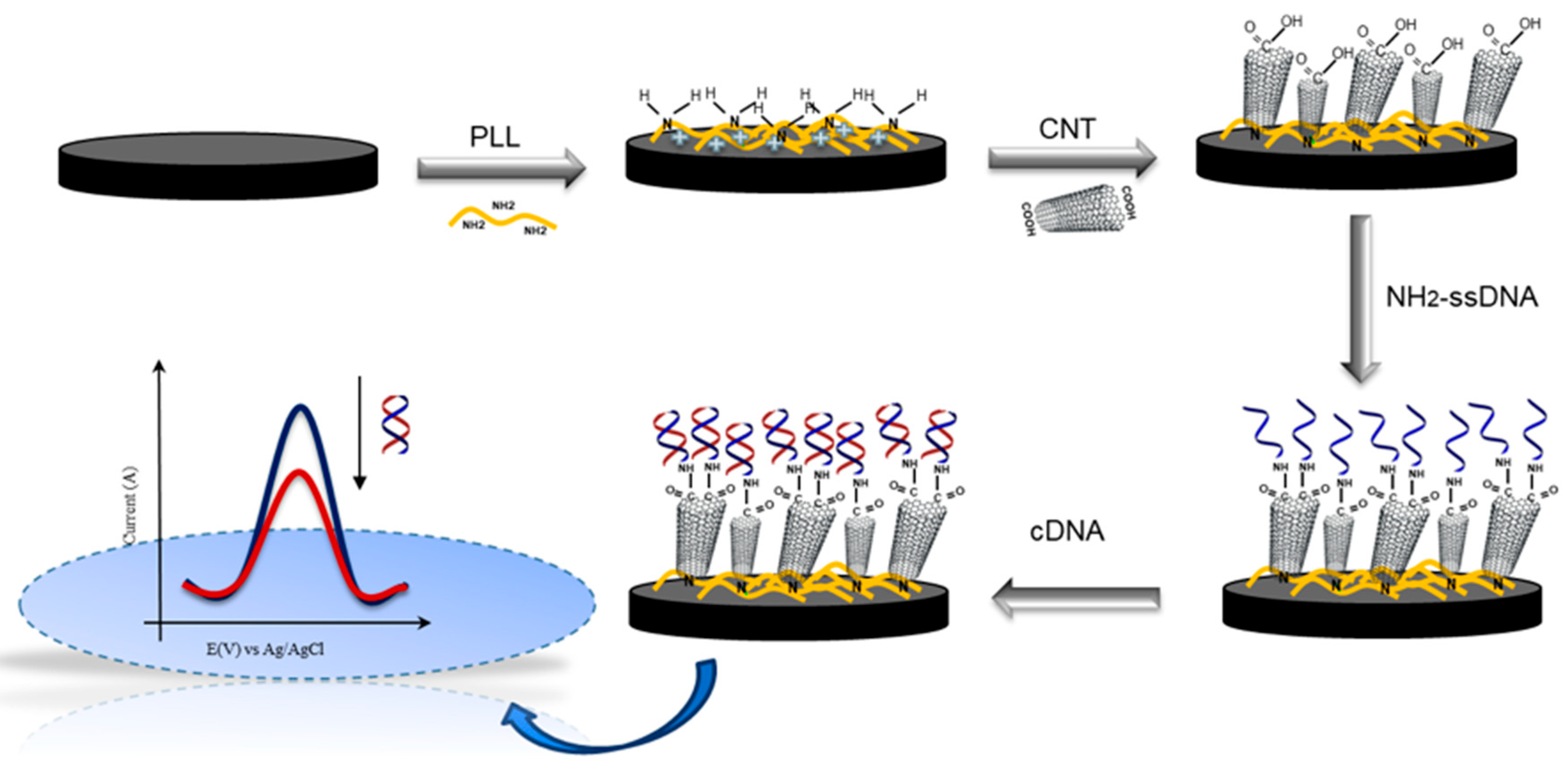
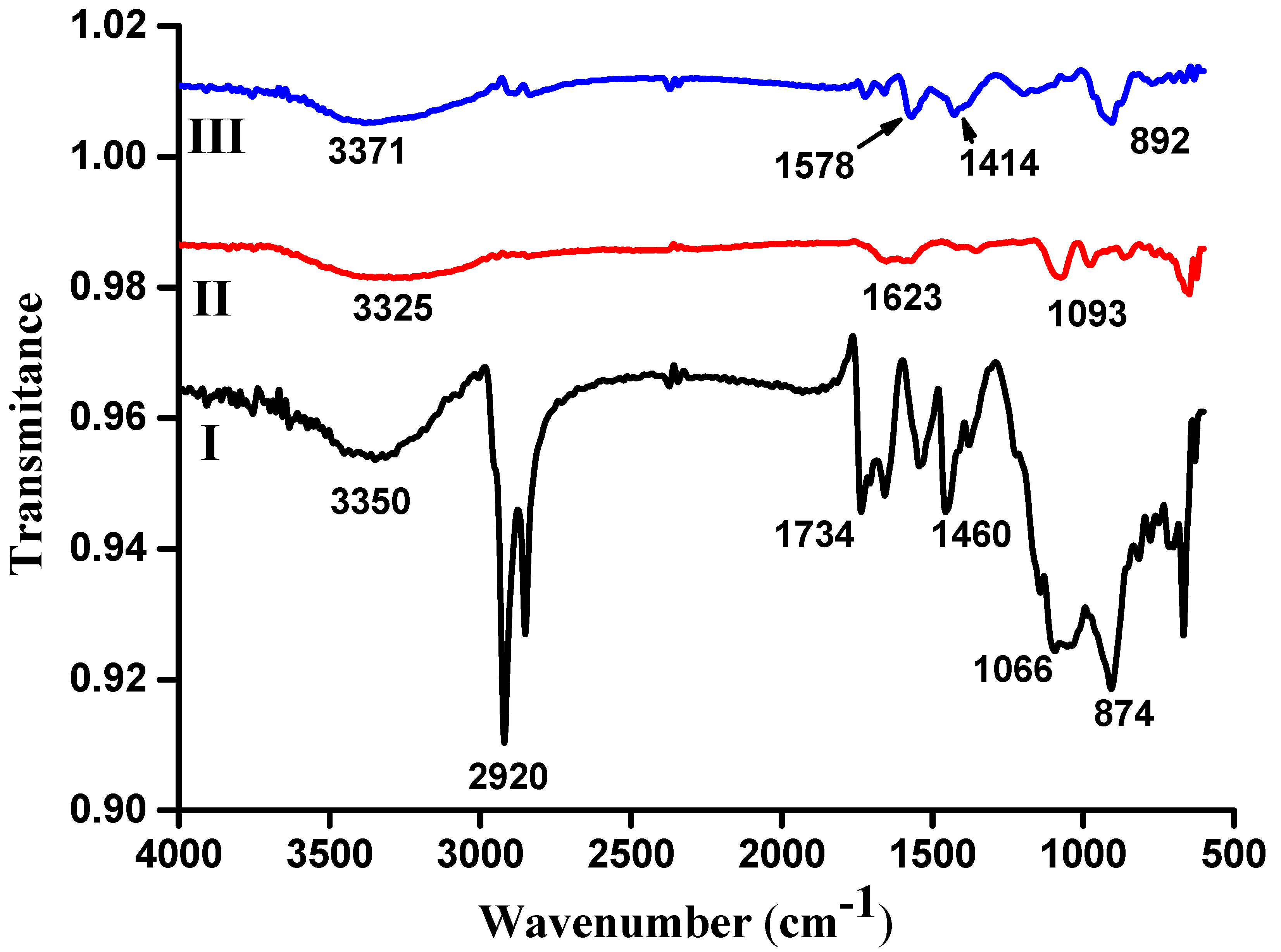

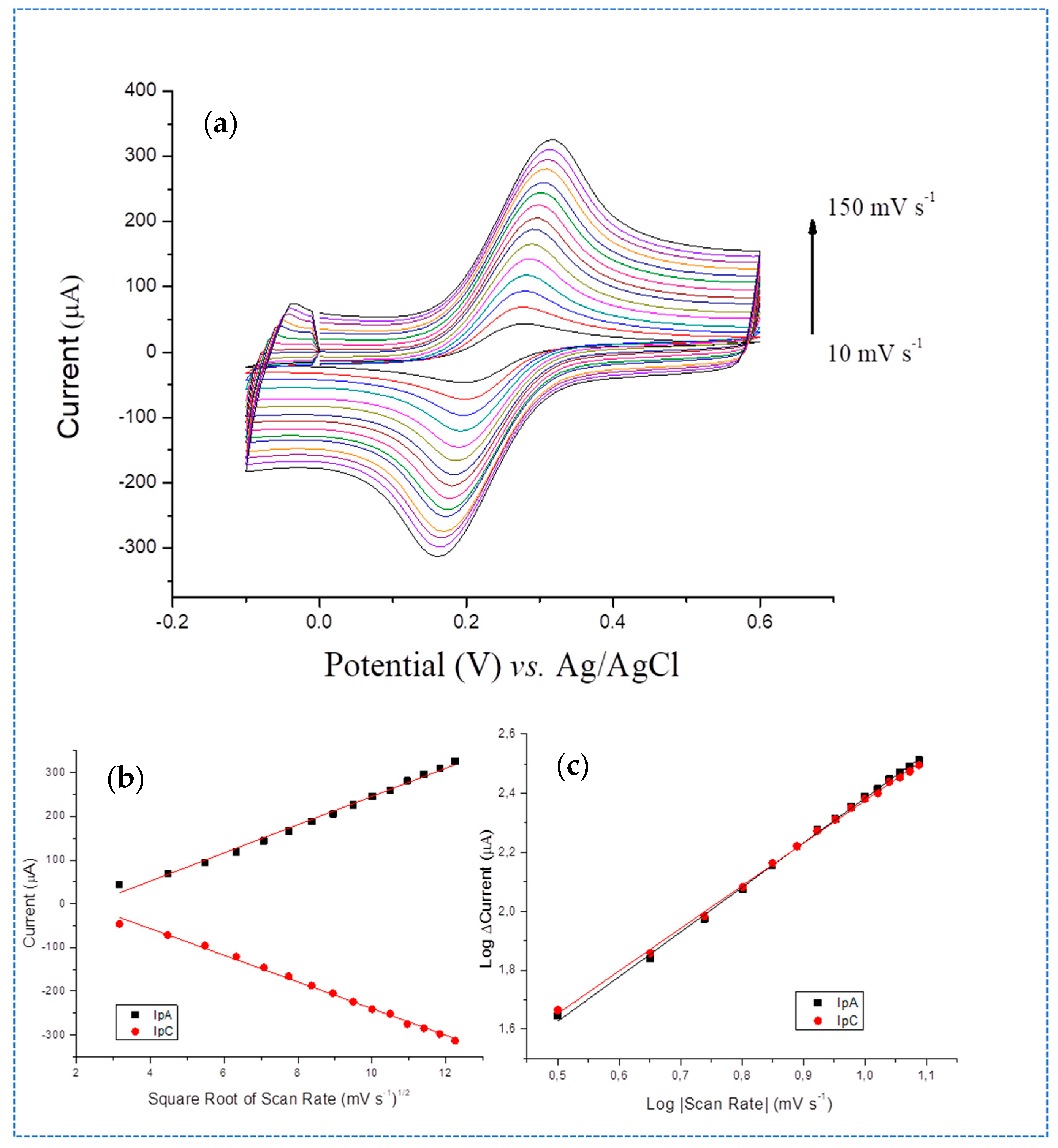

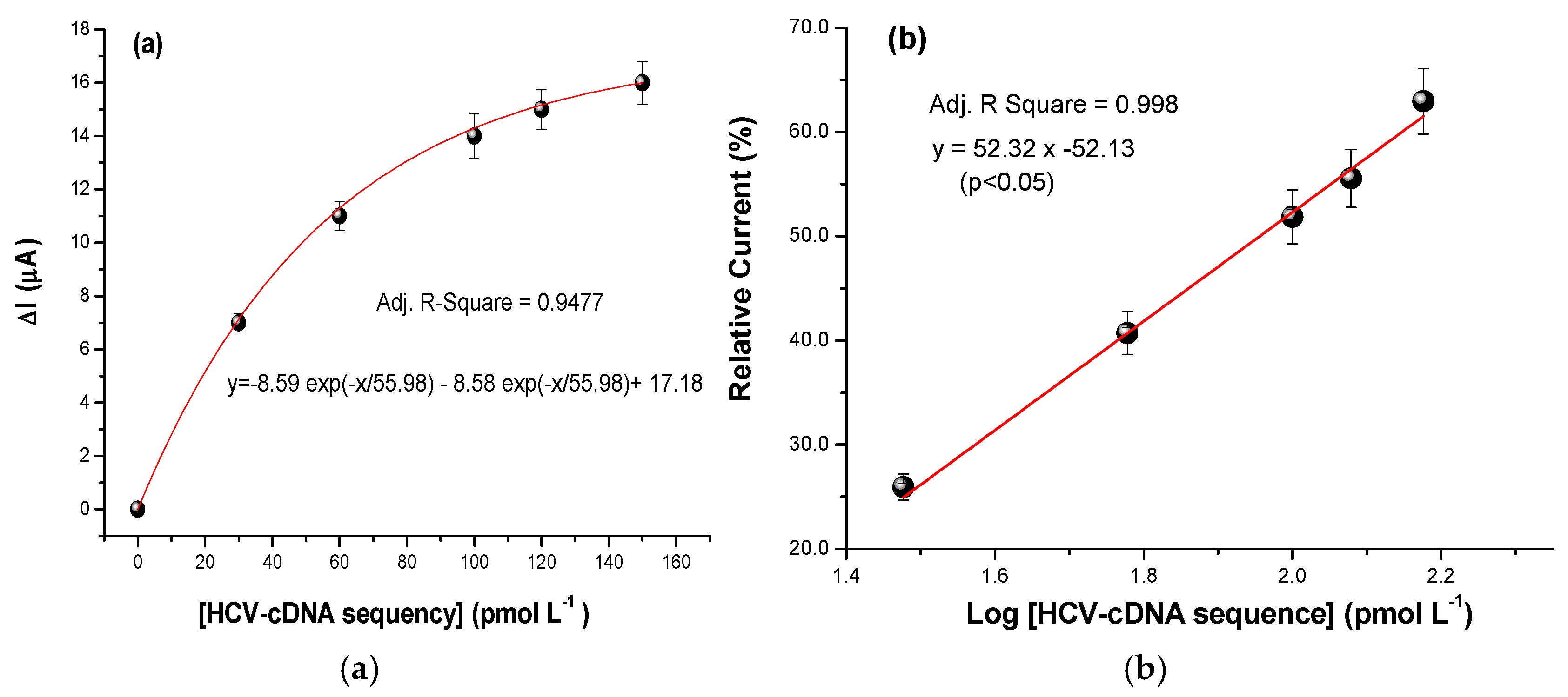
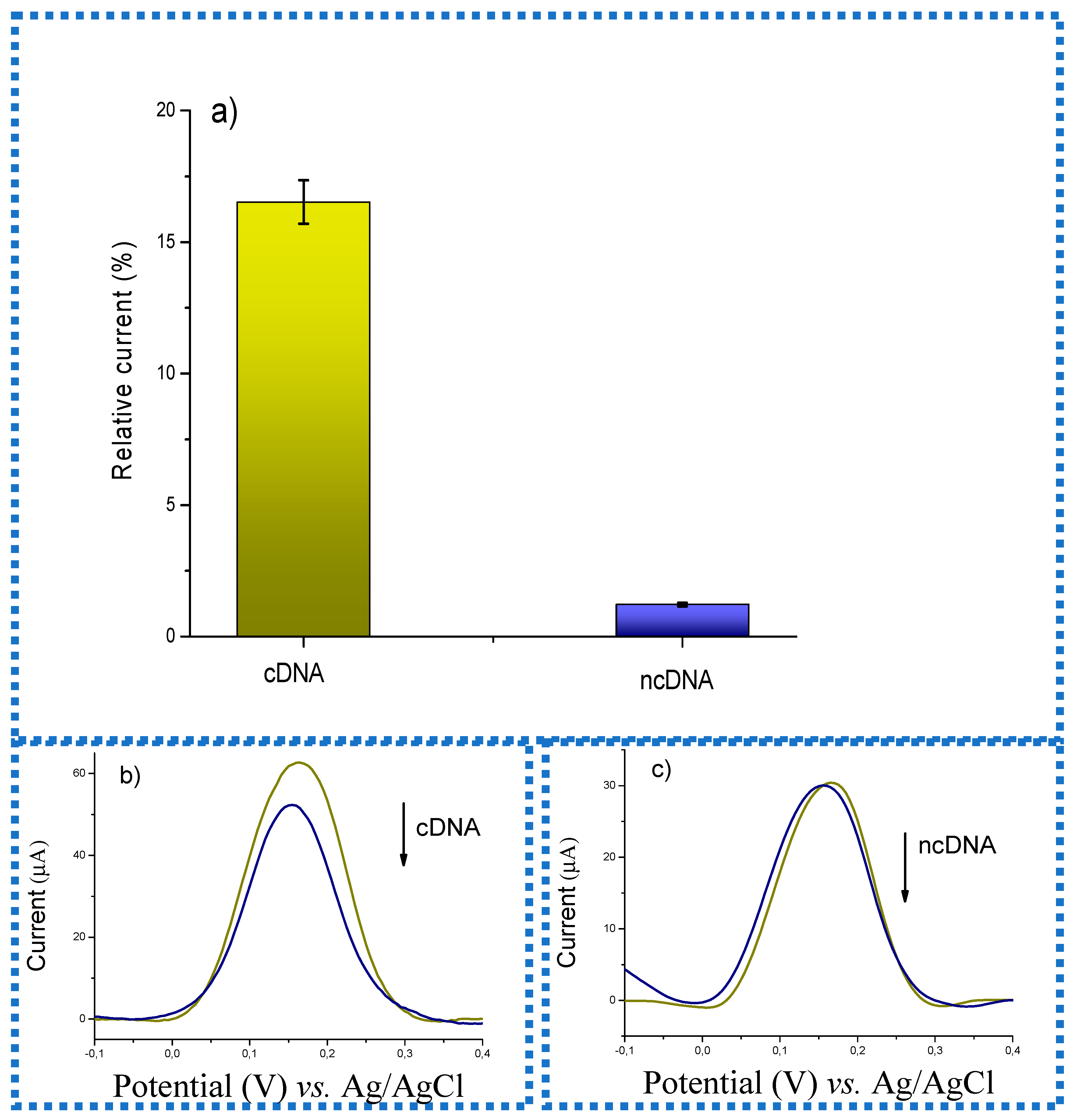
| Electrochemical Hybridization Methods | Limit of Detection HCV Sequence | Reference |
|---|---|---|
| Label-free | 1.36 nmol L−1 | Oliveira et al., 2018 [47] |
| Label-free | 1.2 nmol L−1 | Chittuam at al., 2023 [48] |
| Label-free | 0.75 pmol L−1 | Sheta at al., 2020 [46] |
| Label-free | 1 fmol L−1 | Roohizadeh et al., 2020 [45] |
| Intercalant agent | 0.64 pmol L−1 | El-Sheikh at al., 2021 [43] |
| Intercalant agent | 4 pmol L−1 | Chaibun at al., 2024 [44] |
| This work (label free) | 1.33 pmol L−1 | Santana et al. |
Disclaimer/Publisher’s Note: The statements, opinions and data contained in all publications are solely those of the individual author(s) and contributor(s) and not of MDPI and/or the editor(s). MDPI and/or the editor(s) disclaim responsibility for any injury to people or property resulting from any ideas, methods, instructions or products referred to in the content. |
© 2025 by the authors. Licensee MDPI, Basel, Switzerland. This article is an open access article distributed under the terms and conditions of the Creative Commons Attribution (CC BY) license (https://creativecommons.org/licenses/by/4.0/).
Share and Cite
Santana, G.M.; Souza, A.P.O.; Trindade, E.K.G.; Benjamin, S.R.; Dutra, R.F. Electrochemical DNA Biosensor for Detection of Hepatitis C Virus Using a 3D Poly-L-Lysine/Carbon Nanotube Film. Chemosensors 2025, 13, 379. https://doi.org/10.3390/chemosensors13110379
Santana GM, Souza APO, Trindade EKG, Benjamin SR, Dutra RF. Electrochemical DNA Biosensor for Detection of Hepatitis C Virus Using a 3D Poly-L-Lysine/Carbon Nanotube Film. Chemosensors. 2025; 13(11):379. https://doi.org/10.3390/chemosensors13110379
Chicago/Turabian StyleSantana, Gilvânia M., Anna P. O. Souza, Erika K. G. Trindade, Stephen R. Benjamin, and Rosa Fireman Dutra. 2025. "Electrochemical DNA Biosensor for Detection of Hepatitis C Virus Using a 3D Poly-L-Lysine/Carbon Nanotube Film" Chemosensors 13, no. 11: 379. https://doi.org/10.3390/chemosensors13110379
APA StyleSantana, G. M., Souza, A. P. O., Trindade, E. K. G., Benjamin, S. R., & Dutra, R. F. (2025). Electrochemical DNA Biosensor for Detection of Hepatitis C Virus Using a 3D Poly-L-Lysine/Carbon Nanotube Film. Chemosensors, 13(11), 379. https://doi.org/10.3390/chemosensors13110379







